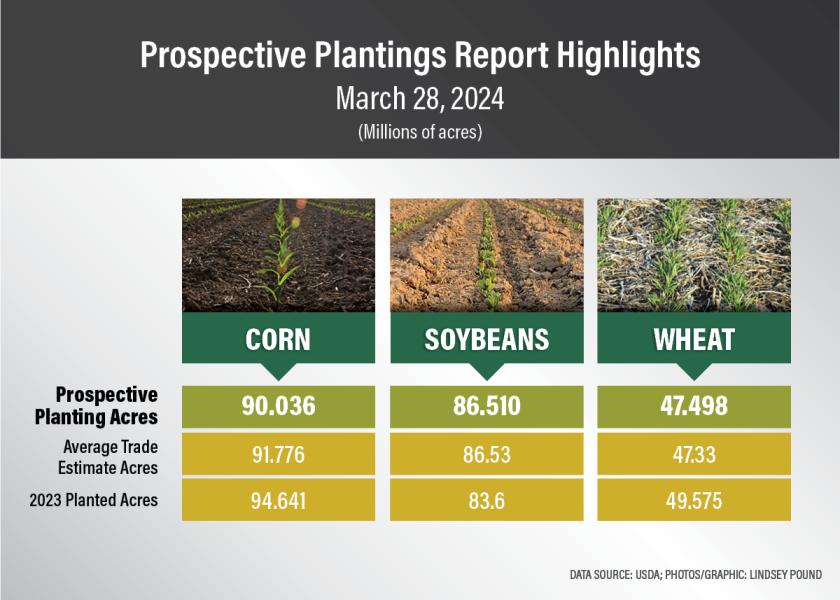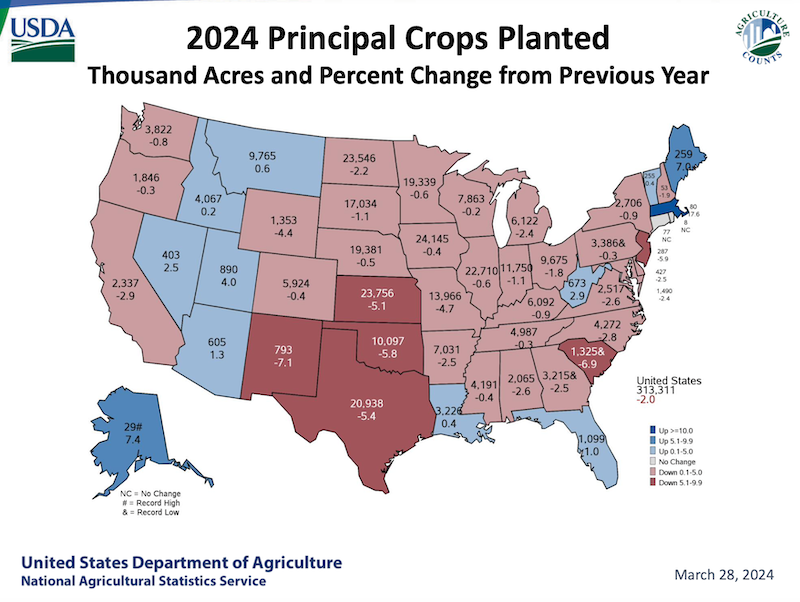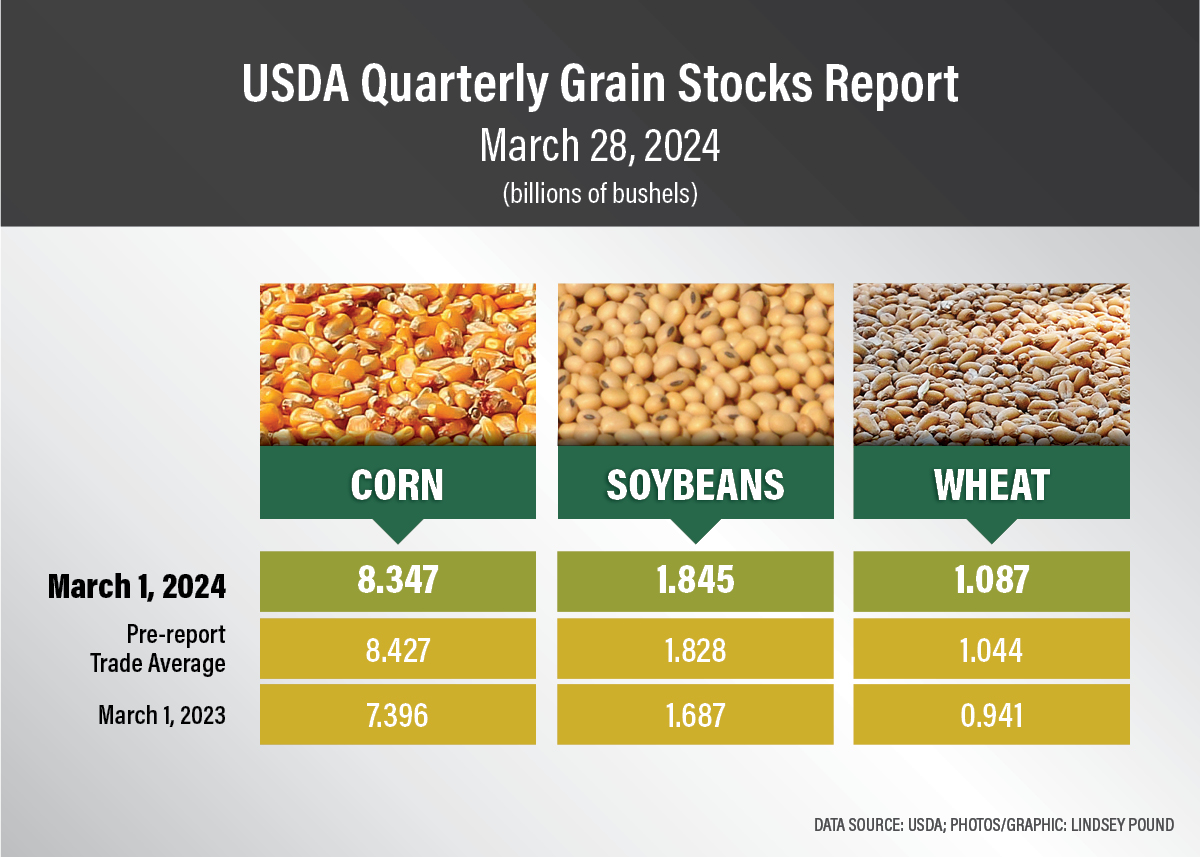Where Did All the Corn Acres and Principal Crop Acres Go? The Two Biggest Questions from USDA's Big Prospective Plantings Report

It’s no surprise farmers intend to plant fewer corn acres than they did in 2024, but USDA’s first survey-based look at acreage shows an even bigger drop than expected.
USDA’s survey found farmers intend to plant less corn and more soybeans this year, which was expected. However, the corn acreage came in much lower than what the trade was anticipating prior to the big report.
Highlights of the 2024 Prospective Plantings report include:
- Corn planted acreage: 90 million, down 5% from 2023
- Soybean acreage: 86.5 million, up 3%
- All wheat acreage: 47.49 million, down 4%
- All cotton acreage: 10.7 million, up 4%

Another big surprise was the drop in overall acres this year. USDA’s report showed principal crop acres fell 6.3 million acres year over year. The biggest decline in overall acreage came in Texas, New Mexico, Oklahoma, Kansas and South Carolina.
Corn Acreage Surprise
When you look at what moved the markets after the report, it's clear the biggest change that caught traders by surprise was the change in corn.
“The biggest surprise for me, of course, was 90 million acres of corn,” says Matt Bennett of Ag Market.net. “We thought that corn acres wouldn't be near as high as what some of the other folks had been saying.”

Bennett says when you look at how ideal the fall was for fall field work, that did lead to the possibility of more corn acres, but he says the economics of the situation has also changed quite a bit.
“We felt like that would temper these corn acres quite a bit, our [AgMarket.Net] estimate was 91.5, but it was a big surprise to come out with 90 million acres, and the trade was certainly surprised by it,” Bennett says.
Where did the corn acres go? USDA shows a double digit decline in nine states, with Arkansas seeing the biggest drop with a 27% decline.
Is This a Momentum-Changer in Corn?
After the report, corn prices shot up 15¢, which Bennett says is affirmation the trade was surprised by the corn acreage number in USDA’s Prospective Plantings report. Does this report change the momentum for corn prices? Joe Vaclavik of Standard Grain thinks it definitely could.
“You’ve got funds short in the corn market, in particular, and maybe some of these large money managers are going to look at this situation or take a second look at the situation following the report,” Vaclavik says. “That being said, what I did after the report was I took the new acreage numbers, I punched it into the USDA Ag Outlook Forum balance sheet for new crop corn, and it's still a bearish situation. It’s still a 2-billion-plus carry out and a 15% or 16% stocks-to-use ratio.”
Listen to report reaction from Joe Vaclavik of Standard Grain and Matt Bennett of AgMarket.Net
He says considering the fund positions, it makes the market more sensitive if the U.S. runs into a weather problem. Vaclavik also says producers have to remember this could be the smallest corn acreage number printed by USDA this year.
“I think there's a strong likelihood that you see a significant acreage shift in the June report, but for now, it's absolutely supportive,” Vaclavik says.
How Accurate is USDA’s Prospective Plantings Report
USDA’s first official look at acreage, which is a farmer survey, typically stirs up quite the debate. The survey asks farmers their planting intentions as of March 1.
“I stop and think about what was a farmer's mentality as of March 1, because it's obviously a survey-based approach. And corn hadn't started rallying yet,” Bennett says. “I have to think that farmers’ mentality was they didn’t even want to plant corn. So, I think Joe's right, you could see a pretty good size shift, especially if you get some strength in this corn market.”
How accurate is USDA’s Prospective Plantings report? Vaclavik says it’s not accurate, which is also a big industry debate on why the report is even released every year.
“It's not accurate, USDA will be the first to tell you that they’re not big fans of this report,” Vaclavik says. “They know that they don't start to get a feel for the acreage situation until June. And even after that there's precedent for sizable adjustments. You can see corn acreage adjusted 2 million in October. For all I know, it's happened before. So this is a starting point. And for the moment, for the moment, these are the numbers until we see new numbers in June.”
The Quarterly Grain Stocks report also added some momentum to corn prices, with corn stocks coming in lower than trade expectations.








